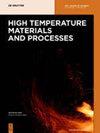Effect of P and Ti on the agglomeration behavior of Al2O3 inclusions in Fe–P–Ti alloys
IF 1.5
4区 材料科学
Q4 MATERIALS SCIENCE, MULTIDISCIPLINARY
引用次数: 0
Abstract
Abstract Nozzle clogging occurs in the interstitial free (IF) steel with high phosphorus (P) more frequently than in IF steel with lower P. To explore the effect of P and Ti on the inclusion behavior in liquid steel, the in situ experiment and theoretical calculations were conducted. High-temperature confocal laser scanning microscopy was used in situ to observe the inclusion behavior at the liquid Fe–P–Ti alloy surfaces, and the attractive and capillary forces were also calculated to quantitatively estimate the effect of P and Ti on the inclusion behavior. The results show that the agglomeration of Al 2 O 3 inclusions involves four steps: dispersed Al 2 O 3 particles in liquid alloy; formation of Al 2 O 3 chain structure; bending of the Al 2 O 3 chain, and sintering and densification of the chain structure. The addition of Ti and P in the steel can increase the agglomeration time of inclusions, indicating the impeding effect of P and Ti on the inclusion aggregation. Furthermore, the orientation factor is proposed to estimate the direction of movement of the small inclusion crossing between large inclusions, and the experimental results confirm its validity.P和Ti对Fe-P-Ti合金中Al2O3夹杂物团聚行为的影响
摘要为探讨P和Ti对钢液中夹杂物行为的影响,进行了原位实验和理论计算。采用高温共聚焦激光扫描显微镜原位观察液态Fe-P-Ti合金表面的夹杂行为,并计算其吸引力和毛细力,定量评价P和Ti对夹杂行为的影响。结果表明:al2o3夹杂物的团聚过程分为四个步骤:al2o3颗粒在合金液中分散;al2o3链结构的形成;al2o3链的弯曲,以及链结构的烧结和致密化。在钢中添加Ti和P可以延长夹杂物的团聚时间,说明P和Ti对夹杂物的团聚有阻碍作用。在此基础上,提出了用取向因子来估计大包裹体间小包裹体交叉运动方向的方法,实验结果验证了该方法的有效性。
本文章由计算机程序翻译,如有差异,请以英文原文为准。
求助全文
约1分钟内获得全文
求助全文
来源期刊

High Temperature Materials and Processes
工程技术-材料科学:综合
CiteScore
2.50
自引率
0.00%
发文量
42
审稿时长
3.9 months
期刊介绍:
High Temperature Materials and Processes offers an international publication forum for new ideas, insights and results related to high-temperature materials and processes in science and technology. The journal publishes original research papers and short communications addressing topics at the forefront of high-temperature materials research including processing of various materials at high temperatures. Occasionally, reviews of a specific topic are included. The journal also publishes special issues featuring ongoing research programs as well as symposia of high-temperature materials and processes, and other related research activities.
Emphasis is placed on the multi-disciplinary nature of high-temperature materials and processes for various materials in a variety of states. Such a nature of the journal will help readers who wish to become acquainted with related subjects by obtaining information of various aspects of high-temperature materials research. The increasing spread of information on these subjects will also help to shed light on relevant topics of high-temperature materials and processes outside of readers’ own core specialties.
 求助内容:
求助内容: 应助结果提醒方式:
应助结果提醒方式:


